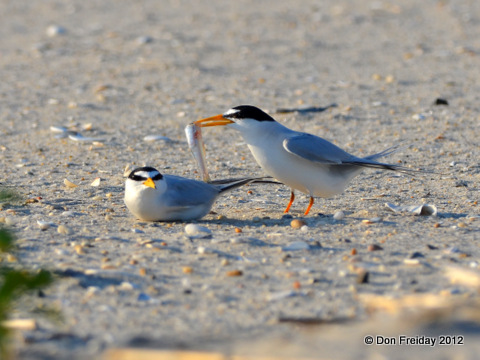[Worm-eating Warblers often probe hanging dead leaves for caterpillars and arthropods, but apparently broken off limbs work, too. Belleplain State Forest, NJ, June 2 2012].
Last Saturday I found myself exploring by bicycle at the "crack" of 1:00 p.m., with my daughter and my fiance, peddling the shady, lightly-traveled roads of Belleplain State Forest. Maybe hard rain the night before had something to do with it, but despite the afternoon hour, every bird you want to find in Belleplain was findable and singing, albeit not with the song frequency you get at dawn, but often enough. So, instead of singing every 10 seconds, maybe the Worm-eating Warbler sings every 30 seconds, or even only once a minute. If you go slow enough, like on a bike or on foot, you're still going to hear it, it and the Hooded, Yellow-throated, Blue-winged, Black-and-White and Prothonotary Warblers, Acadian and Great-crested Flycatchers, Summer Tanagers and all the rest. If you're not in a hurry, you can stop, scan, listen, reposition, scan some more, and see them. Especially because later in the day birds get off their high horse of territory maintenance and set about the work of everyday living - collecting nest material, perhaps, or, by early June, feeding young or bathing in a stream. Good chances for observing behavior. Try the afternoon in your local patch, and see what you find.
[Yellow-billed Cuckoo, one of 5 we found in Belleplain Saturday. Note the boldly patterned tail, which is more muted in Black-billed. And, of course, the yellow lower mandible.]
And another thing about later in the day - things that are "cold-blooded" move more, so you have the bonus of interesting "herps" (short for herptiles, which means reptiles and amphibians) and insects in the afternoon that hide from the dawn chill. Cold-blooded should be put in quotes because what these things really are is ectothermic - they get their heat from outside their bodies, but do quite the good job of it by basking, and can warm up and be as active as a mammal or bird.
[Five-lined Skink gleaming like a tropical creature, Belleplain on Saturday.]
[Male Ebony Jewelwing, right, a damselfly, and its mate, on Poison Ivy near the Sunset Bridge in Belleplain on Saturday.]
All this - the active neotropical migrant birds, colorful herps and insects, warm and humid air, reminds me that the mid-Atlantic in summer is not so different from the famously diverse and wonderful tropics. Hek, Worm-eating Warblers winter mainly on both slopes of Central America, and Yellow-billed Cuckoos substantially farther south than that. Might as well call the eastern forest the tropics north, and so let it be said that the mid-Atlantic forest should be known famously as diverse and wonderful.
And just after I go and think that, literally the very evening after our Belleplain outing I open Mark Garland's Watching Nature and read, "I don't recall when the connection first became clear to me, but slowly the parallels developed in my mind: In summer, our eastern deciduous forest has a distinctly tropical flavor. Many elements of the tropical rainforest's incredible complexity could be seen right in my backyard."
You pegged it, buddy. I suppose this is as good a place as any to mention that Mark and I will be leading a tour next year, not to the tropics but to very special Big Bend National Park and environs in West Texas next April. More info on that tour will appear hear soon.
[Eastern Painted Turtle egg-laying along a sand road in Belleplain. June is egg-laying month for all sorts of turtles - e.g. also Diamond-backed Terrapins along salt marsh causeways - so please drive with great caution, and help your neighborhood turtles across the street, always in the direction they were traveling when you spotted them.]
Another thing about afternoon is that the light can develop these fabulous warm tones, and creatures at the edge of the sea remain as active, or more so, as they were in early morning. So Sunday afternoon we wandered down to Cape May Point State Park for the first time in a good long while, to check on the terns and beach-nesters.
[The sound of a ripping sheet, "aaaarcchh" or something like that, alerted us to this Caspian Tern over Bunker Pond in Cape May Point State Park on Sunday. Just a couple have been around Cape May Point recently. The heavy body, thick, mostly red bill and dark underside to the primaries eliminates Royal Tern, which was also present.]
[You've just got to walk the beach at Cape May Point State Park and the South Cape Meadows to enjoy the Least Tern show.]
["Take it, honey, please. . ." "No, I want ice cream!"]
[Fledgling Piping Plover forages between waves along the South Cape May Meadows Beach Sunday evening. How can't you love this bird, which struggles mightily to survive against overwhelming human impacts and disturbance on the coast?]
[Makes you glad you're not the size of a Piping Plover chick - we watched this huge (4") Ghost Crab scuttle across the beach and dune, searching for whatever prey it could find - which would include Piping Plover, if it could catch one. And they sometimes do.]










Thanks for the nod, amigo. Don't suppose you want to hear about Alaska. We'll have all the details in place for that West Texas trip before the end of June. But for now, I leave Prince William Sound tomorrow and take the group to Sheep Mountain Lodge. Oh how I wish for Don's eyes to spot the Hawk-Owls!
ReplyDelete